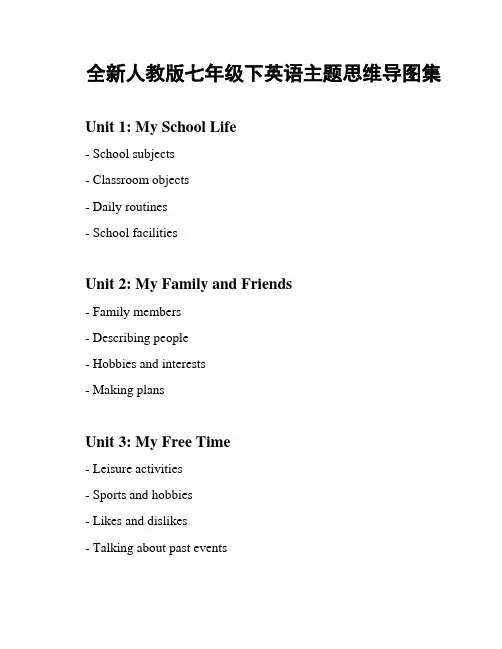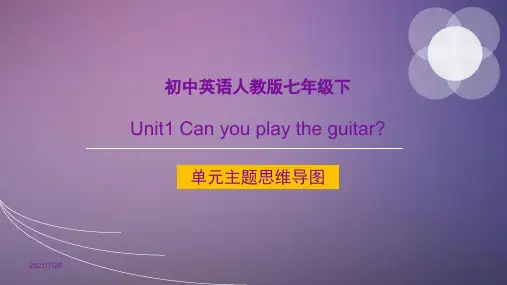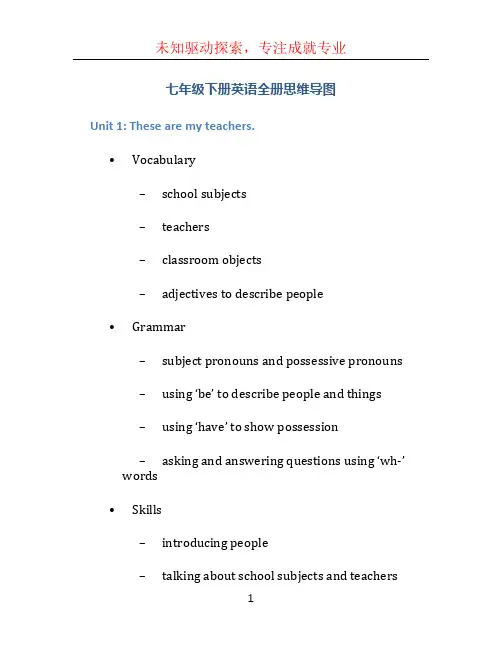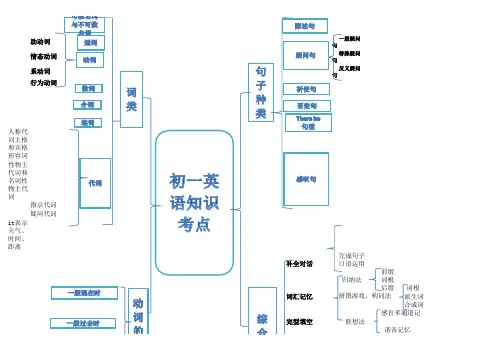初一英语思维导图
- 格式:docx
- 大小:13.43 KB
- 文档页数:1



全新人教版七年级下英语主题思维导图集Unit 1: My School Life- School subjects- Classroom objects- Daily routines- School facilitiesUnit 2: My Family and Friends- Family members- Describing people- Hobbies and interests- Making plansUnit 3: My Free Time- Leisure activities- Sports and hobbies- Likes and dislikes- Talking about past eventsUnit 4: My Home- Rooms and furniture- Describing a house- Daily chores- Talking about future plansUnit 5: My City- Asking for ns- Places in the city- Modes of n- Giving ns about a cityUnit 6: My Daily Routine - Time and daily activities- Describing daily routines- Talking about habits- Expressing preferencesUnit 7: My Clothes- Clothing items- Colors and patterns- Describing outfits- Shopping for clothesUnit 8: My Food- Food and drinks- Describing tastes- Ordering food in a restaurant - Talking about food preferencesUnit 9: My Health- Parts of the body- Describing ailments- Giving advice- Talking about healthy habitsUnit 10: My Holidays- Holiday activities- Talking about past ns- Making travel plans- Describing a dream holiday以上是《全新人教版七年级下英语》的主题思维导图集,帮助学生系统地了解和掌握每个单元的主题内容。




七年级下册英语全册思维导图Unit 1: These are my teachers.•Vocabulary–school subjects–teachers–classroom objects–adjectives to describe people•Grammar–subject pronouns and possessive pronouns–using ‘be’ to describe people and things–using ‘have’ to show possession–asking and answering questions using ‘wh-’ words•Skills–introducing people–talking about school subjects and teachers–describing people–asking and answering questions about possessionUnit 2: This is my school.•Vocabulary–places in a school–prepositions of place–numbers 1-1000–adverbs of frequency•Grammar–using ‘there is’ and ‘there are’–using the verb ‘have’ with objects and rooms–using prepositions to describe location–forming questions with ‘where’ and giving answers•Skills–talking about your school–giving directions in a school–describing locations–asking and answering questions about places Unit 3: How do you study for a test?•Vocabulary–school activities and supplies–adverbs of manner–adjectives to describe actions–time expressions•Grammar–using present simple tense to talk about routines and habits–using adverbs of manner to describe how things are done–using adjectives to describe actions–using time expressions to talk about frequency •Skills–talking about daily routines–discussing how to study for a test–describing actions using adjectives–expressing frequency using adverbsUnit 4: I love learning English!•Vocabulary–adjectives describing feelings–types of music–activities–opinions•Grammar–using present continuous tense to talk about actions happening now–using ‘like’, ‘love’, ‘enjoy’ to talk about hobbies and activities–using adjectives to describe feelings–expressing opinions using ‘I think’, ‘I believe’•Skills–talking about hobbies and activities–expressing likes and dislikes–describing feelings–giving opinionsUnit 5: How’s the weather?•Vocabulary–weather conditions–seasons–types of clothing•Grammar–using present simple tense to talk about weather–using ‘it’ to refer to the weather–using prepositional phrases to describe weather conditions•Skills–talking about the weather–describing seasons and clothing–making predictions about the weather–giving weather forecastsUnit 6: What’s your favorite day?•Vocabulary–days of the week–activities–ordinal numbers–adjectives to describe activities•Grammar–using ‘what’ to ask about favorite things–using ordinal numbers to talk about the order of days–using adjectives to describe activities •Skills–talking about favorite activities–discussing daily routines on different days–using ordinal numbers–describing activities using adjectivesUnit 7: I want to be a basketball player.•Vocabulary–jobs–sports–school subjects related to jobs–adjectives to describe jobs•Grammar–using ‘want to’ to talk about future plans–using ‘be going to’ to talk about future intentions–using adjectives to describe jobs–using ‘because’ to give reasons•Skills–talking about future plans and intentions–discussing different jobs–describing jobs using adjectives–giving reasons using ‘because’Unit 8: Where’s the post office?•Vocabulary–places in a city–directions–prepositions of movement–adjectives to describe cities•Grammar–using ‘Can you…’ to ask for help–using imperatives to give instructions–using prepositions of movement to give directions–using ‘there is’ and ‘there are’ to talk about places in a city•Skills–asking for and giving directions–describing places in a city–using imperatives to give instructions–talking about different citiesUnit 9: How do you make a banana smoothie?•Vocabulary–food and drinks–kitchen utensils–imperatives for cooking–adjectives to describe food and taste •Grammar–using imperatives to give instructions for cooking–using ‘how much’ and ‘how many’ to ask about quantities–using adjectives to describe food and taste–using ‘like’ to express preferences•Skills–talking about cooking and food preferences–giving instructions for making a recipe–describing food and taste–asking about quantitiesUnit 10: I’m watching TV.•Vocabulary–activities–types of TV programs–time expressions–adjectives to describe TV programs •Grammar–using present continuous tense to talk about actions happening now未知驱动探索,专注成就专业–using adjectives to describe TV programs–using time expressions to talk about frequency •Skills–discussing TV programs and activities–talking about what is happening now–describing TV programs using adjectives–expressing frequency of activities11。




初一英语思维导图
思维导图是一种将放射性思考具体化的方法,是一种展现个人智力潜能极致的方法,可提升思考技巧,大幅增强记忆力、组织力与创造力。
在日常初一英语教学实践操作的基础上,在教学反思的前提下,将初一英语思维导图应用在阅读理解中,以期有效激发学生学习英语的兴趣,提升英语教学及学生学习的效果。
对于初一新生来说,英语学习必须建立在轻松理解的基础上,如果一味的语法或句法讲解,只会是学生徒添伤悲,对于提高英语兴趣毫无益处。
因此,初一英语思维导图与阅读理解相互结合,赋予学生更多的自主权,激发创新能力,更好的做到个性化学习,增强学生合作意识。
这些方面的改变最终会带来英语学习方式向自主学习、个性化学习、合作对话学习、有意义学习的转变。
学生阅读文章的过程是学生已有的认知图式与文本信息交互作用和意义建构的过程。
学生将已有的认知图式与文本信息联系起来并彼此匹配时,就能理解材料的内容。
传统的阅读教学,不少教师往往只注重向学生传授词汇、语法等语言知识,而无视了内容图式和形式图式的训练,造成学生过多的关注语言知识,而忽视对文章整体意义的理解。
在讲解阅读理解是,教师只是将对答案和讲解相关习题最为重中之重,教师的分析取代了学生的动脑思考过程。
通过思维导图与英语阅读理解结合应用,通过其在初一英语教学中的应用,将教学的过程及结果呈献出来,加深了学生的理解和接受。
词与文相结合,避免孤立片面;将所想解决的文章通过导图的方式,能够划出文章的脉络结构,便于分析和掌握。